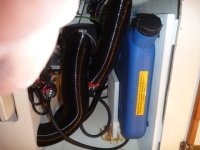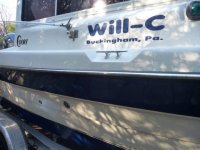In the mapping stages of heater project. was wondering where everyone placed there thru hull exhaust at? it would be easier and have more of a down bens(hopefully keeping water out ) if I placed it just below the accent line on the next rib down. same place my sink drain is at. I would be able to put it just below rub rail on the accent color but would be more of a straight over for exhaust and no down angle? any input one way or the other plan on drilling this weekend.
You are using an out of date browser. It may not display this or other websites correctly.
You should upgrade or use an alternative browser.
You should upgrade or use an alternative browser.
where did most put heater exhaust thru hull?
- Thread starter Jake B
- Start date
...just below the accent line on the next rib down. same place my sink drain is at.
that's where factory installed mine.
jd
I don't know what stove you're installing, but the Wallas 1300 heater I'm putting in comes with instructions that require the exhaust exit to be at least a certain minimum below the high point in the exhaust line, and at least a certain minimum above the water line. That leaves a very narrow band to choose from - if I a fudge a millimeter or two, I think I can mount it just above the bottom edge of the green accent strip, otherwise the flange of the exhaust port will overlap the green and be partly on the white. I haven't decided yet whether compulsion to do it exactly by the book or esthetic considerations will rule.
There are a lot of competing considerations:
- What do the instruction say, if anything;
- Will the hot exhaust port be near open windows, fenders, lines, boarding access, fuel fillers or vents;
- Will there be good air flow across the opening?
There are a lot of competing considerations:
- What do the instruction say, if anything;
- Will the hot exhaust port be near open windows, fenders, lines, boarding access, fuel fillers or vents;
- Will there be good air flow across the opening?
thanks for the replys, and pic that is where it would fit best with a good down ward angle. nimrod do you ever notice water getting your thru hull? I am still dry fitting, but lower like in the pic posted would be the easiest to do i will look again initial read of instal instructions didn't say one way or the other. the thru hull i go does have upward angle on it as well to help eliminate water intrusion
tcr_pnw":x0yaab72 said:Up as high above the waterline as possible!
I'm not sure I'd always go for that. Reason I say it is that is ... isn't it good to have an upward loop inside the boat? My original fuel vents were placed as high as possible on the topsides (thus no loop would fit) and I changed it, lowering them, and adding a trap type fixture (since I could still not fit a loop).
Maybe you meant "as high as possible" *with* a loop and if so... never mind! I just couldn't tell for sure.
canal charterguy
New member
My thru hull fitting on my 05 22' cruiser is located as in the picture and was installed at the factory. We fish the boat in sloppy seas in the straits and ocean.It has always been wet under the cabinet. I scratched my head and ran towels under there for a VERY long time. I also tried applying a sealant barrier on the inside to no avail. Finally a couple of seasons ago I put a standard rubber drain plug in outside the hull and no problems since. I am very safety minded and don't like this option but it is dry under the cabinet when the unit is not in use. JUST REMEMBER TO REMOVE THE PLUG BEFORE TURNING ON. I also always run a carbon monoxide detector. If there is an option to go higher on the exhaust I would.
When I talked with the folks at Scan Marine about moving my Wallas stove/heater they told me to be sure to use plenty of high temp RTV when mounting the exhaust flange because the flange is only tack welded to the tail pipe and not fully welded. This allows water to seep in around the outer flange and the pipe the exhaust hose is connected to. I made sure to pack RTV into the very small gap and used plenty under the flange where it sits against the hull. So far no leaks.
OMG, after 9 years, my question has finally been answered. I always wondered why water would appear under the cabinet. It was very random but I thought it might be coming in through the Wallas exhaust thru hull. Now my suspicions have been answered. I guess I need to follow the suggestions in this thread in order to fix the issue.
Thanks guys! Peter
Thanks guys! Peter
thanks for all the replies. I looked again today and for some reason I was thinking I would have to mount heater as high as I could but after looking again today if I mount in the middle I can get a good up bend and still exhaust in the accent area. I have the high temp stuff just waiting on a few parts then ill get it in and post some pics. thanks
mgarr682":2qpa4c9i said:When I talked with the folks at Scan Marine about moving my Wallas stove/heater they told me to be sure to use plenty of high temp RTV when mounting the exhaust flange. . ..
What brand of RTV did you use? Life Seal says it's good to 400 degrees F, and I was thinking I'd use that. I know pure silicone is good at high temperatures but I hate the stuff - it's the devil to remove from gelcoat.
NORO LIM":3vjlb04w said:mgarr682":3vjlb04w said:When I talked with the folks at Scan Marine about moving my Wallas stove/heater they told me to be sure to use plenty of high temp RTV when mounting the exhaust flange. . ..
What brand of RTV did you use? Life Seal says it's good to 400 degrees F, and I was thinking I'd use that. I know pure silicone is good at high temperatures but I hate the stuff - it's the devil to remove from gelcoat.
I used Permatex 81160. According to their data sheet it's good to 600F. It's available at just about any auto parts store. When I installed the outlet I was on the inside the boat tightening the nuts while my wife was outside the boat holding the screws with a screw driver. As the goo oozed out my wife would immediately wipe it away with a paper towel. When we were finished there was no clean up. Just keep plenty of paper towels handy.
Also keep in mind that you might have electrical cables and engine control cables running through the area where you plan to make the upward loop in the exhaust line. That area is a bit different in the Angler vs. the Cruiser. You'll want to keep the exhaust pipe away from them as it does get hot, although the fiberglass sleeve does make a huge difference.
NORO LIM":2phaxtck said:mgarr682":2phaxtck said:When I talked with the folks at Scan Marine about moving my Wallas stove/heater they told me to be sure to use plenty of high temp RTV when mounting the exhaust flange. . ..
What brand of RTV did you use? Life Seal says it's good to 400 degrees F, and I was thinking I'd use that. I know pure silicone is good at high temperatures but I hate the stuff - it's the devil to remove from gelcoat.
I used Permatex 81160. According to their data sheet it's good to 600F. It's available at just about any auto parts store. When I installed the outlet I was on the inside the boat tightening the nuts while my wife was outside the boat holding the screws with a screw driver. As the goo oozed out my wife would immediately wipe it away with a paper towel. When we were finished there was no clean up. Just keep plenty of paper towels handy.
Also keep in mind that you might have electrical cables and engine control cables running through the area where you plan to make the upward loop in the exhaust line. That area is a bit different in the Angler vs. the Cruiser. You'll want to keep the exhaust pipe away from them as it does get hot, although the fiberglass sleeve does make a huge difference.
figured i would put this here rather than start a new thread. got heater installed and fired it up last night for the first time. as well as put a few pics in my album. my question to all you owners with heaters is I wrapped the exhaust and muffler 3 times with exhaust wrap but even after heater running for 10-15 min i could only hold onto it for 2-3 seconds before it got too hot. I did notice that things in close proximity were not getting hot, but I plan to run this for hours on end. and my main concern is this is under the sink and stove. Also stored in the same cabinet is the diesel fuel tank, a gallon of alcohol for stove, 2 gallons of diesel to refill heater, a gallon of e-tech oil ect. So a lot of flammable stuff . I originally bought some sheet metal to make a deflector but the way the install went I would loose a lot of space making this. I'm wondering if this is normal or if I need to do something more to keep exhaust cool to the touch. I thought about wrapping it in dryer vent? I also have soon on here some people have what looks like a white sock over theres? any input would be great thanks. it is nice having warm air in cabin tho....

I used the white sheath wire tied at each end over the heaters exhaust and then put that inside a two inch duct to further shield anything that should not be toasted from being toasted. The left hose is the heat duct the one to the right is combustion exhaust. The local Espar guy recommended I do that.
D.D.

We cut a hole with 1/4'' clearance around the tube where the exhaust pipe connected and where it goes thru the hull. 3M 5200 on the outside of the through hull where the thru hull meets fiberglass and a insulating washer on the inside that came with the through hull fitting. As recommended by the local Espar people in Maryland. Been good so far. Our fitting is a threaded type with a large nut on the inside which is the way it tightens up.
D.D.

